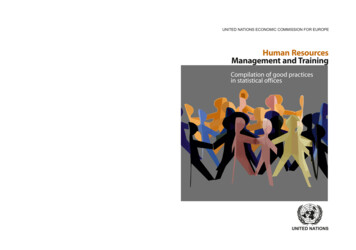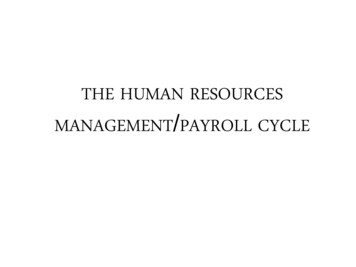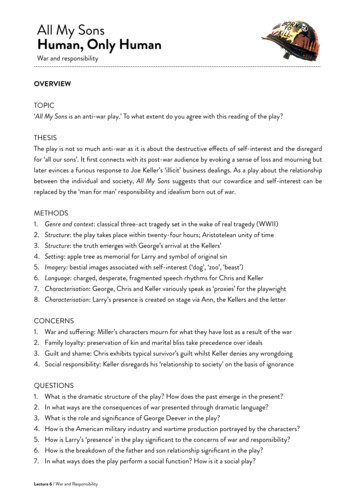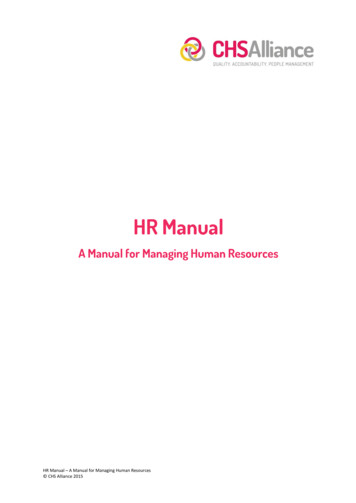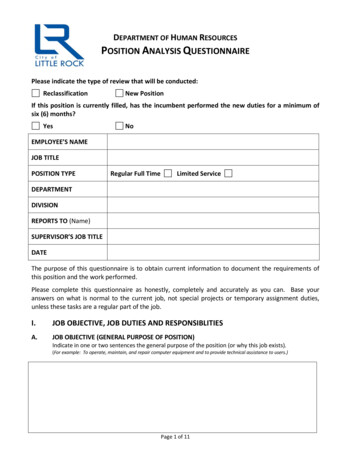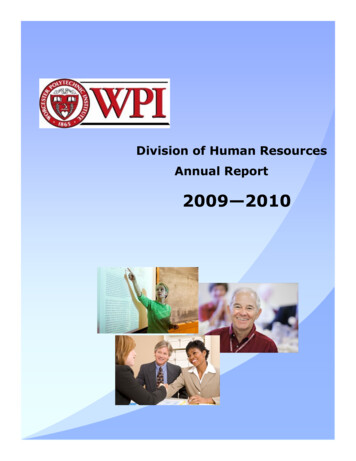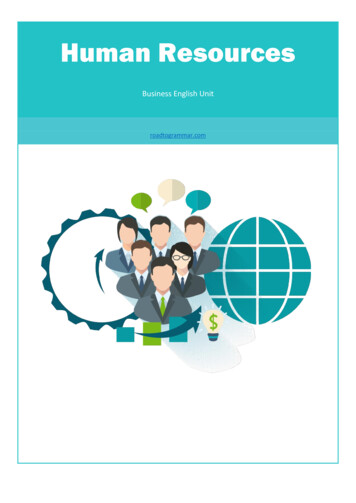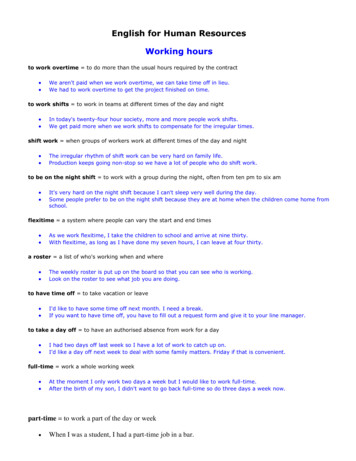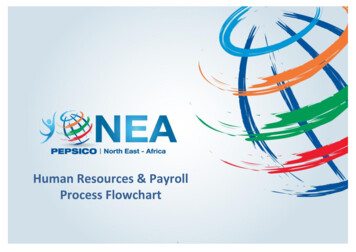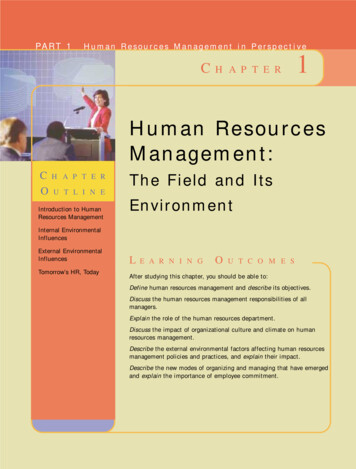
Transcription
PA R T 1Human Resources Management in PerspectiveChapter1Human ResourcesManagement:ChapterOutlineIntroduction to HumanResources ManagementThe Field and ItsEnvironmentInternal EnvironmentalInfluencesExternal EnvironmentalInfluencesTomorrow’s HR, TodayLearningOutcomesAfter studying this chapter, you should be able to:Define human resources management and describe its objectives.Discuss the human resources management responsibilities of allmanagers.Explain the role of the human resources department.Discuss the impact of organizational culture and climate on humanresources management.Describe the external environmental factors affecting human resourcesmanagement policies and practices, and explain their impact.Describe the new modes of organizing and managing that have emergedand explain the importance of employee commitment.
2Part 1Human Resources Management in PerspectiveIntroduction to Human Resources ManagementIn 1994, a noted leader in the human resources (HR) field made the followingobservation:1Yesterday, the company with the access to the most capital or the latest technologyhad the best competitive advantage. Today, companies that offer products with thehighest quality are the ones with a leg up on the competition. But the only thing thatwill uphold a company’s advantage tomorrow is the calibre of people in the organization.That predicted future is today’s reality. Most managers in public- and privatesector firms of all sizes would agree that people truly are the organization’s mostimportant asset. Having competent staff on the payroll does not guarantee thata firm’s human resources will be a source of competitive advantage, however. Inorder to remain competitive, grow, and diversify, an organization must ensurethat its employees are qualified, placed in appropriate positions, properlytrained, managed effectively, and committed to the firm’s success. Achievingthese goals is the aim of human resources management, the field that is exploredin this text.What is Human Resources Management?human resources management(HRM)The activities, policies, andpractices involved in obtaining,developing, utilizing, evaluating,maintaining, and retaining theappropriate number and skill mixof employees to accomplish theorganization’s objectives.Human resources management (HRM) refers to the management of people inorganizations. It comprises the activities, policies, and practices involved inobtaining, developing, utilizing, evaluating, maintaining, and retaining theappropriate number and skill mix of employees to accomplish the organization’sobjectives. The goal of HRM is to maximize employees’ contributions in orderto achieve optimal productivity and effectiveness, while simultaneously attaining individual objectives (such as having a challenging job and obtaining recognition), and societal objectives (such as legal compliance and demonstratingsocial responsibility).2Objectives of Human Resources ManagementThe objectives of HRM include: assisting the organization in obtaining the right number and types ofemployees to fulfill its strategic and operational goals helping to create a climate in which employees are encouraged to developand utilize their skills to the fullest helping to maintain performance standards and increase productivitythrough effective job design; providing adequate orientation, training anddevelopment; providing performance-related feedback; and ensuring effective two-way communication helping to establish and maintain a harmonious employer/employee relationship helping to create and maintain a safe and healthy work environment developing programs to meet the economic, psychological, and social needsof the employees
Chapter 1Human Resources Management: The Field and Its Environment3 helping the organization to retain productive employees ensuring that the organization is in compliance with provincial/territorialand federal laws affecting the workplace (such as human rights, employment equity, occupational health and safety, employment standards, andlabour relations legislation).Rather than addressing organizational goals as separate and distinct fromthose of employees, they should be seen as compatible and mutually inclusive.A win–win situation results when this occurs. As explained by communicationsconsultant Katie Delahaye Paine:3When you align HR with organizational strategy, you’ll see growth in employee commitment, improved financial results, and find yourself better able to attract andretain the right people for your organization’s business and culture.Why is Human Resources Management Importantto All Managers?Gateway to Hot HR Siteswww.io.org/ pmi/p5.htmlManagers at all levels must concern themselves with HRM, since they all meettheir goals through the efforts of others, which requires the effective management of people. Every supervisor and manager has responsibilities related to awide range of HRM activities. These include analyzing jobs, planning labourneeds, selecting employees, orienting and training employees, managing compensation, communicating (which includes counselling and disciplining), andmaintaining employee commitment. They also include ensuring fair treatment;appraising performance; ensuring employee health and safety; building andmaintaining good employee/labour relations; handling complaints and grievances; and ensuring compliance with human rights, occupational health andsafety, labour relations, and other legislation affecting the workplace. Regardlessof field of expertise, from accounting to production control, learning aboutemployee rights, employer responsibilities, and effective HRM practices canprovide managers with knowledge that will enable them to perform more effectively.This book is designed to provide information that will assist individuals whoare currently working in an HR department or in a supervisory or managerialcapacity in another department (or planning to assume such responsibilities inthe future). As explained by Jim Frank, vice-president and chief economist atThe Conference Board of Canada,4“You can see it so clearly. Some organizations in the same industry are more successful than others, and it’s because theyhave different leadership—leadership that is able to mobilize its people aroundits goals and objectives.”At no time in history have effective HRM skills been more important thanthey are today. As we will discuss in a moment, such factors as increasing workforce diversity; rapidly changing technology; increasing government involvement in the employer–employee relationship; and globalization, have triggeredan avalanche of change, one that many firms have not survived. In such an environment, the future belongs to those managers who can best manage change,but to manage change, they must have committed employees who do their jobsas if they own the company. Throughout this book, we will demonstrate thatsound HRM practices and policies can play a crucial role in fostering suchemployee commitment and enabling organizations to better respond to change.
4Part 1Human Resources Management in PerspectiveCurrent Human Resources ManagementFunctionsMany studies have shownthat employees are morecommitted to their jobswhen their participation isvalued and encouraged.Here, assembly-line workersin a Tokyo Nissan factoryparticipate in a workerproductivity session attended by managers andsupervisors.authorityThe right to make decisions, directthe work of others, and give orders.line authorityAuthorization given to managers todirect the work of those reportingto them and make decisions aboutoperational issues.line managerAn individual who is in charge ofan aspect of operations directlylinked to the organization’s product(s) or service(s).Except for very small businesses, most firms today have an HR departmentheaded by an HR professional. To understand how the duties of this individual and other HR department staff relate to the HRM duties of managersthroughout the rest of the organization, it is helpful to distinguish amongline, staff, and functional authority.Authority is the right to make decisions, direct the work of others, andgive orders.Line authority authorizes managers to direct the work of those reportingto them and make decisions about operational issues, and may be exercisedonly over employees in a manager’s direct chain of command. HR professionals, for example, have line authority within the HR department and oftenin such service areas as the lunchroom or cafeteria.Individuals known as line managers are in charge of an aspect of operations directly linked to the organization’s product(s) or service(s). Hotel managers, directors of patient care, retail store managers, and managers of production and sales are generally line managers.Staff authority, in contrast to line authority, authorizes managers to assist,counsel, advise, or provide service to others, but does not include the right to director control. Such authority is derived from acquired expertise and knowledge.Individuals with staff authority must rely primarily upon their ability to thinkstrategically, their reputation, and their powers of persuasion to gain the confidenceand respect of other managers. HR professionals, for example, are responsible foradvising other managers on issues ranging from selection and training to grievancehandling and disciplinary action, but cannot give those managers direct orders.Managers in charge of functions or departments that are not directly linkedto the organization’s product(s) or service(s), but which provide assistance andsupport, are known as staff managers. HR managers, accounting managers, andmanagers of information technology (IT) are generally staff managers.Functional authority involves authorization to make final decisions on issuesaffecting other departments or aspects of operations. The HR department isgenerally given functional authority for highly technical activities, such as compensation and benefits administration, and activities for which centralizationenhances efficiency and effectiveness, such as recruitment. Having each department manager make decisions about pay structures, benefits, or recruitmentmethods could lead to inequities and excessive costs, and would be highly inefficient. The delegation of functional authority to the HR department to handlesuch matters ensures control (including consistent application and legal compliance), cost-efficiency, and uniformity.staff authorityThe authority to assist, counsel,advise, or provide service to others,but not to direct or control theiractivities.Human Resources Management Responsibilities ofAll Managersstaff managerThe person in charge of a functionor department that is not directlylinked to the organization’s product(s) or service(s), but rather provides assistance and support.According to one expert, “The direct handling of people is, and always hasbeen, an integral part of every manager’s responsibility, from president downto the lowest-level supervisor.”5In small organizations, managers may carry out all of their HRM dutiesunassisted. As the organization grows, however, they often need the assistance,specialized knowledge, and advice of a separate human resources staff.6
Chapter 1functional authorityAuthorization to make final decisions on issues affecting otherdepartments or aspects of operations. The HR department is generally given functional authority forhighly technical activities, such ascompensation and benefits administration, and activities for whichcentralization enhances efficiencyand effectiveness, such as recruitment.Human Resources Management: The Field and Its Environment5Organization size and complexity are generally major factors in senior management’s decision to establish an HR department. As an organization grows,managing human resources effectively and ensuring legal compliance becomemore of a burden. Once department managers and first-line supervisors find thatHRM activities interfere with their other responsibilities, the benefits of delegating some of their HRM tasks to a separate HR department are generally seento exceed the costs of establishing such an entity.The Role of the Human Resources DepartmentOnce an HR department has been created, it is the unit that has overallresponsibility for HRM programs and activities. The primary role of the HRdepartment is to ensure that the organization’s human resources are utilizedeffectively and managed in compliance with company policies and procedures,government legislation, and, in unionized settings, collective agreement(s). Toeffectively utilize the HR department’s assistance and services, all managersshould be familiar with its role.HR department staff members are involved in five distinct types of activities:formulating policies and procedures, offering advice, providing services, monitoring to ensure compliance, and serving as consultant and change agent.Formulating Policies and ProcedurespolicyA predetermined guide to thinking,established to provide direction indecision making.procedureA prescribed sequence of steps tobe followed when implementingorganizational policies.The head of the HR department usually plays a leadership role in initiating andformulating HR policies and procedures that are consistent with overall organizational objectives. These must also be compatible with current economic conditions, collective bargaining trends, and applicable employment legislation.Often, though, the actual formulation of HR policies and procedures forapproval by senior management is a cooperative endeavour among managers,nonmanagerial employees, and HR department staff. A policy is a predetermined guide to thinking, established to provide direction in decision making.Policies are extremely important because they define the organization’s positionon given issues; communicate management’s expectations of employees; articulate acceptable/unacceptable behaviour; ensure consistency in the treatment ofemployees and continuit
Human resources management (HRM) refers to the management of people in organizations. It comprises the activities, policies, and practices involved in obtaining, developing, utilizing, evaluating, maintaining, and retaining the appropriate number and skill mix of employees to accomplish the organization’s objectives. The goal of HRM is to maximize employees’ contributions in order to .File Size: 513KBPage Count: 44


